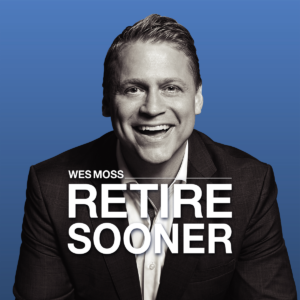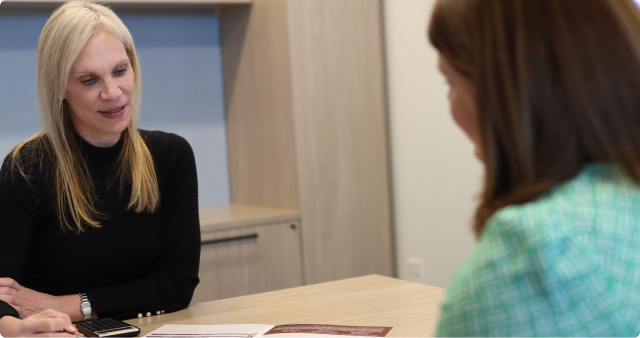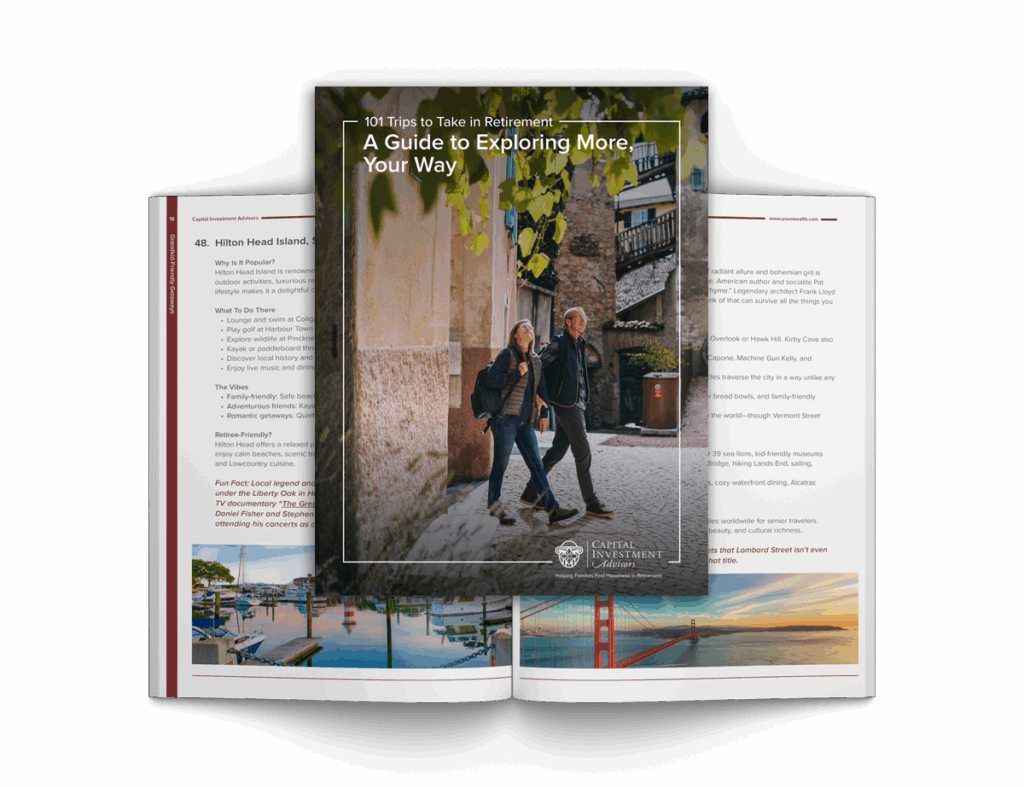Cut through market fear, witness inspiring stories, and tackle the challenging housing market with optimism and insight. Gain the clarity you need to seek financial freedom and retirement happiness. Wes and Jeff explore the week’s essential themes, including:
-
The S&P 500, dividend stocks, and bonds posting gains that were higher than many had feared. After a sharp drop in April, markets rebounded strongly, marking the best May in 35 years.
-
Inflation hit a four-year low, calming fears and fueling market optimism.
-
A pop-up chicken stand that became Dave’s Hot Chicken, is now valued near $1 billion. Is chicken catching up to beef in the world of fast food?
-
Long-term stock investing continues to demonstrate effectiveness: no 12-year period in the S&P 500 over the last 90 years has shown a loss.
-
Home buying is becoming more challenging for younger Americans. What has the new median first-time buyer age risen to?
-
U.S. housing transactions have plummeted. Is it due to high mortgage rates? Low mobility? Both?
-
Can a pension can be treated like a bond in a retirement allocation strategy?
-
A listener from Idaho highlights how millions of Americans with pensions may benefit from tailored planning beyond 401(k)s.
-
Jeff and Wes wrap with favorite burger spots—and the effect that Sunday closures seem to have on Chick-fil-A.
Read The Full Transcript From This Episode
(click below to expand and read the full interview)
- Wes Moss [00:00:02]:
The Q ratio, average convergence, divergence, basis points and BS. Financial shows love to sound smart, but on Money Matters we want to make you smart. That’s why the goal is to keep you informed and empowered. Our focus providing clear, actionable information without the financial jargon to help 1 million families retire sooner and happier, bigger. Based on the long running WSB radio show, this Money Matters podcast is tailor made for both modern retirees and those still in the planning stages. Join us in this exciting new chapter and let’s journey toward a financially secure and joyful retirement together. Wes Moss here with co host Jeff Lloyd in studio. Welcome to you Jeff Lloyd.Jeff Lloyd [00:00:53]:
Thank you, Wes. Great to be back in the studio with you this morning.Wes Moss [00:00:56]:
There’s so much data on chicken. When I say chicken, I mean the chicken industry. When it comes to chicken sandwiches, think chick fil A versus burgers, think McDonald’s. And there was a fascinating article this week. We’re going to get to chicken in a minute. I think that I wanted to start off today with, with just remembering and emphasizing where we are when it comes to markets. The general stock market S&P 500 versus dividend stocks versus bonds. That’s a, that is a chart that frequently will update.Wes Moss [00:01:26]:
I want to know how the market’s done relative to how, how which S&P 500 would call that relatively tech heavy versus dividend stocks, which is less tech heavy. Still some technology because technology companies still pay dividends. But other areas are emphasize that typically more often and then bonds for safety. What do those markets have done so far in 2025? And we’ve basically it’s been kind of an interesting as we sit here today, it’s kind of been a round trip. We start out the year had a little bit of gains. Then tariff talks kicked in in march whammy. On April 2nd you’re going to go back because we’re really two months from that day. Then we had this cascade waterfall decline.Wes Moss [00:02:08]:
Then it wasn’t as bad for dividend paying stocks. They held up the S&P 500 at one point. Intraday was down 20%. Bear market didn’t quite close there. And then here we are back for the year. If we’re looking at what is now not so much of a young year, we’re not fully halfway through. We’re getting there. We’re almost halfway through the year and we’re up, let’s call it around 2% for the S&P, around 2 for dividend stocks.Wes Moss [00:02:33]:
And guess what? Bonds have basically stayed flat and really not gone down and if you’re looking at the total return so far for the aggregate bond index, right around 2% as well. So those three major areas that I look at, one of them didn’t have a whole lot of volatility. It’s up about 2%. One had some volatility, up about 2%. One had tremendous volatility, up about 2%. And that’s kind of where we stand as investors. So that even though this year really feels like it’s been a rough year, and this is just conversations I’ve had over the last couple of weeks with folks doing planning, I’ve heard, oh, I haven’t looked at my statements because I’m nervous that it’s been really bad. How bad? How bad is it? Have you heard that one, Jeff? Late.Wes Moss [00:03:17]:
How bad is it?Jeff Lloyd [00:03:18]:
Yeah, and they’re kind of wincing and just tell it to me softly.Wes Moss [00:03:23]:
Yeah.Jeff Lloyd [00:03:24]:
And that conversation at the end of March was different than it was at the end of April. And then it was different at the end of May after we saw the best May in the stock market in 35 years.Wes Moss [00:03:37]:
You put all that together, it’s probably a lot less bad than you think so far this year as an investor in your 401k. And I’d say it’s better than most people think where we are today. Now, again, this could all change. But that’s, that’s the kind of the round trip that we’ve been on. So if you’ve been afraid to look at your 401k so far in 2025, it’s okay. Look, go ahead, look at it. Log in today when you have a few minutes, see how it’s done. And it’s probably, it will surprise you a little bit to the upside.Wes Moss [00:04:06]:
So I think that’s a little bit of the good news. If we were to go back though, over that two month period of time. Jeff Lloyd, you did a little bit of a timeline this week that’s interesting.Jeff Lloyd [00:04:16]:
Just going back two months. And remember that here on Money Matters and Investing, we don’t look at investments on a two month timeframe. I just think that this is a good exercise.Wes Moss [00:04:27]:
But you just did though, this year.Jeff Lloyd [00:04:29]:
To remind us of what can happen in two months.Wes Moss [00:04:31]:
We don’t look at it on a two month time, but yet you did look at on two.Jeff Lloyd [00:04:34]:
Full disclaimer.Wes Moss [00:04:35]:
Kind of like, what season is it?Jeff Lloyd [00:04:38]:
Let’s go back two months ago to April 8th. Okay.Wes Moss [00:04:41]:
By the way, I was gonna go, I’m going with summer, even though it’s officially Unofficially, summer.Jeff Lloyd [00:04:47]:
It’s unofficially, officially summer. Unofficially, summer in the Moss and Lloyd.Wes Moss [00:04:50]:
Households, of course it is.Jeff Lloyd [00:04:51]:
Kids are out of school, it’s summer.Wes Moss [00:04:52]:
It’s not technically summer, but we’re in June, Kids are out of school, it’s summer, particularly down here in the South.Jeff Lloyd [00:04:59]:
But let’s go back to the spring. Let’s go back to April 8th. Let’s go back two months. Okay. The S&P 500 was down almost 20%, Nasdaq off by nearly 25%. You had investor panic. You had financial media panic. You saw the headlines on CNBC and Bloomberg.Jeff Lloyd [00:05:19]:
Tariffs, hey, the world’s never going to be the same, okay? Never going to be, never going to be the same.Wes Moss [00:05:26]:
We’re running straight into a brick wall. And there were a couple of days where it felt a little bit like that.Jeff Lloyd [00:05:31]:
What’s happened in the last two months? We got a trade pause or a tariff pause. We experienced, like I said, the best May in 35 years. Corporate earnings. We had a good corporate earnings season. Q1, the S&P 500 saw its eighth best day in its history. Inflation dropped to four year lows, down to 2.3%. Oh yeah, and we saw the S&P 500 rebound about 20% and the NASDAQ rebound about 25%.Wes Moss [00:06:04]:
And that’s all just in two months.Jeff Lloyd [00:06:06]:
All in two months.Wes Moss [00:06:07]:
Even though that we don’t look at investing in two month periods of time. I think we’ll make an exception here. Jeff LLOYD but really the pain was real. I mean, you look at April 3, April 4, the aggregate loss in the market, if you’re adding it all up, and again, this is, on paper, it was almost $7 trillion in value in.Jeff Lloyd [00:06:25]:
Just those two days alone. Almost $7 trillion and value wiped out of the stock market.Wes Moss [00:06:32]:
So the perspective here is that the, and we will reiterate this because I think this is, it’s helpful for me as, as, and I do this every day and think about investing every single day and read headlines every day. The news around a headline might have a giant impact that day, but then it may take a month or a week or two months or six months for the market to, to have a real dose of reality, what the headline means in real life. So the headline itself is scary. And well, this you’re extrapolating, remember, it’s the, what’s the scarier boogeyman, the one that’s right in front of you or the worry that there’s a boogeyman around the corner? That’s the scary boogeyman that’s why the suspense music plays up and you’ve got the high pitched violins and it’s dark in the house because you don’t know who’s coming out from around the corner. That’s what’s scary. Once these problems and these issues come into focus, we can see them for what they are. Ironically, the fear just goes down. It’s just like, whoa.Wes Moss [00:07:31]:
Well, there’s the scary. It’s scary still, but it’s a little less scary than before. It came around out of the corner behind a mountain. If you’re maybe looking at like a Godzilla type movie, the or underneath the ocean, wait, oh, it’s coming up. It’s going to hit the ship. It’s scarier before. Well, in that case, Jeff Lloyd, I don’t know if you remember the Godzilla versus maybe King Kong. I’m talking about where that once that thing came out of the water, it was maybe even scarier.Jeff Lloyd [00:07:57]:
Yes, I remember that. And do you remember what Godzilla came out of at the beginning of the movie where it was the iceberg?Wes Moss [00:08:03]:
It was frozen, kind of like inflation was frozen for almost 15 years. And the inflation dragon melted during COVID started flying around again. It hasn’t gone back into the ice. It’s better than where we were. The other story that I think is just fascinating to me for this week is and this brings up the kind of the chicken versus beef debate, but it’s really a story about entrepreneurship and it’s a story about America and how there’s still great opportunity. Where else do you see three buddies? One of them a standup comedian, Jeff Lloyd in LA, who was I think making 50 bucks a day or maybe his buddy was making $50 a day in a restaurant. And for some reason they thought, well, let’s take on the chicken market. And they had so little money that they cobbled together as friends a whopping $900 to get started.Wes Moss [00:08:59]:
And that was just enough. And they, I guess technically, eventually they got to a food truck. But if you look at their first couple weeks of sales, I think it was they just had a fryer and a heat lamp out like at a park somewhere.Jeff Lloyd [00:09:13]:
It was just a pop up restaurant in a parking lot.Wes Moss [00:09:15]:
And who eats at a pop up shop at a park? You know who the first customers were?Jeff Lloyd [00:09:21]:
Oh, it was the guy’s like girlfriends.Wes Moss [00:09:22]:
And her three friends and her chicken sales that day. Now fast forward a little bit. That is. And that was just in 2017, which doesn’t seem like all that long ago. They named it Dave’s Hot Chicken.Jeff Lloyd [00:09:36]:
Yeah, Dave’s. Have you ever eaten out of Dave’s Hot Chicken? I. I have not either.Wes Moss [00:09:39]:
I think it’s West Coast. Sounds like this Hollywood story makes sense. That’s in la, but it’s Dave’s Hot Chicken. Just this past week or so. Sold a majority stake. Remember 2017, 900 bucks cobbled together. Heat lamp next to a park. They sold four of these.Wes Moss [00:09:56]:
Just sold a majority stake to private equity, Rourke Capital, who, by the way, I think is in Atlanta.Jeff Lloyd [00:10:02]:
Based out of Atlanta. That’s right.Wes Moss [00:10:04]:
In a deal reportedly or quote, pretty close to a billion dollars. $900 to a billion. Did you run the internal rate of return on that one?Jeff Lloyd [00:10:14]:
So we go from $900 pulling together $900 in a abandoned parking lot to valuing Dave’s Hot Chicken at a billion dollars.Wes Moss [00:10:25]:
One of the guys with 50 bucks, Armand, was making 50 bucks a night as a standup comic. His buddy Dave and Tommy helped him out to launch the Nashville hot chicken stand. $150 fryer, borrowed tables they set up in East Hollywood, and they made 40 bucks on their first night.Jeff Lloyd [00:10:46]:
So I just ran the numbers on just the total return. If you’re talking about $900 turning into.Wes Moss [00:10:52]:
A billion over eight years.Jeff Lloyd [00:10:54]:
Over eight years.Wes Moss [00:10:55]:
Let’s run it.Jeff Lloyd [00:10:57]:
The total return is 111 million percent.Wes Moss [00:11:04]:
And really these stories are good and bad because then you see the investors here in 2019. So Samuel L. Jackson put money in this thing. Michael Strahan put money into this thing. And it reminds me that and this is what is so fascinating about investing. And whether it’s in a publicly traded stock that’s nascent or a private company, it’s these stories that are very real. And these guys are now 100 millionaires because they’re splitting up this money. It keeps so many other deals alive.Wes Moss [00:11:33]:
And a home run deal like this, it’s a one in probably a one in a million type deal. But it keeps the maybe out there and it keeps that risk capital that we have in the United States versus a place like Europe. Well, in this case, there probably. There wasn’t much at risk capital was 900 bucks. I think they had to borrow somebody to open up their first store. But it is interesting that I think of us as. I still think of chicken places like Chick Fil a way behind hamburgers. And I think of us as still a hamburger nation.Wes Moss [00:12:08]:
But that has really been changing. And we went back and looked at the revenue of the whole industry. The burger industry is still almost 170 billion. And the chicken sandwich industry is about 61 billion. And it seems as though, and I guess these numbers are hard to figure out exactly because I don’t think of KFC as a chicken sandwich place. So if you’re looking at just chicken sandwiches, Chick fil a is, is really a huge part of that. It’s maybe a third, maybe more than that. But the one thing that you, you can really tell from the last 15 years is that that industry itself has really picked up a lot of ground.Wes Moss [00:12:47]:
It’s been a steadier rise for hamburgers because there’s still more places that sell hamburgers and there’s more locations. It’s hard to target with the size of some of the top 10. But the trajectory and the rate of change, there’s been, there’s just been more growth. And I think, I think that’s how you get a company like a Dave’s Hot Chicken, which is only 300 locations. It’s got 600 some million in sales last year. I think if you’re the reason a private equity firm is probably interested in a company like that, is that the Excel, there’s more growth there. And they look at that and they say, wow, they’re doing almost, they’re going to do a billion next year. How do we take that to 3 billion quicker than we could if it was in the, let’s call it a more, maybe more mature burger industry.Wes Moss [00:13:32]:
And, and really, if you think about it, McDonald’s is almost, it’s over 13,000 locations and Burger King is almost 7,000. Wendy’s is 6,000. You got to go all the way down. I thought maybe because it’s more prevalent here in the Southeast, but Steak and Shake is number 12 with 400. Only 400 locations. And that’s a company that went public. Have you ever heard of. By the way, Jeff Lloyd, what is number.Wes Moss [00:14:00]:
Let’s see on this list. 11 on the list. Just outside the top 10, Culver’s.Jeff Lloyd [00:14:05]:
I have heard of Culver’s, but I’ve never eaten at one. But I’ve seen them build a few more around the South. I’ve seen them on i20 a bunch. I’ve seen them up in North Georgia a bunch.Wes Moss [00:14:16]:
It’s a Michigan.Jeff Lloyd [00:14:16]:
Oh, it’s Michigan.Wes Moss [00:14:17]:
I don’t know exactly that.Jeff Lloyd [00:14:19]:
We always got to talk. We always got to, we always have to mention Michigan on money matters.Wes Moss [00:14:24]:
I’m always trying to bring it up. My kids love that. Best burger for you. Best burger place in Atlanta.Jeff Lloyd [00:14:29]:
My favorite burger place is Holman And.Wes Moss [00:14:31]:
Finch can’t argue with that.Jeff Lloyd [00:14:33]:
How about you?Wes Moss [00:14:34]:
Def. I would say Grindhouse I actually love.Jeff Lloyd [00:14:37]:
Grindhouse is good.Wes Moss [00:14:38]:
I love Shake Shack is the number one. It’s not a franchise, but it’s hard to beat Grindhouse. What is it? Grindhouse. They have almost two names. It’s Grindhouse Killer Killer Burger, Killer Burger Grindhouse. All right, we got to run to a quick break. We come back, we’re talking housing and markets. More Money Matters straight ahead.Wes Moss [00:14:58]:
Are you facing a fork in the road and deciding between continuing your career and retirement? I’m Wes Moss, host of Money Matters and this massive life decision shouldn’t be taken lightly. Talk with my team. If you’d like help reviewing your retirement accounts and building a financial plan, we can help you review options and offer an opinion based on your best interests. You can find us@yourwealth.com that’s y o u r wealth.com I want to get to US housing market, which we can say is broken by looking at the average age of the median US Home buyer. Just gone. It’s gotten so much older. Back in the 1980s, it was late 20s the first time home buyer and again first time homebuyer today is now 38. So it’s risen 10 years and then the overall person that’s transacting in a home has risen from call it 36 back in 2002 all the way to 56.Wes Moss [00:16:02]:
So it’s 20 years older, not even, well, let’s call it about 20 years later. And there’s some, obviously there’s some reasons around that. The question is what happens? Where do we go from here? Do we get, do we stay stuck in the mud and transactions are low because people just aren’t moving? And what would will help that? How do we help America have more younger people get into get into homes? Before we do that though, I wanted to you ran a couple of data points and one of my favorite charts of the week goes back to the the best and worst S&P 500 annualized return. So best annualized annual returns for the market if you’re looking at different holding periods. So we earlier the show you brought up, we were looking this last two crazy months and we’re somewhat on the other side of that. Not to say something else won’t pop up. But volatility has come down, markets have rebounded. And if you hadn’t, if you looked at your 401k at the beginning of this year in 2025 and then you went to let’s say you you traveled the, you went on a four month cruise.Wes Moss [00:17:11]:
And by the way, I was actually talking to a family of mine that I’ve worked with for many years planning the first time I’ve heard this in a little while. Around the world cruise.Jeff Lloyd [00:17:21]:
Do you know like which route you take? Yes, I want to, I want to hear some details.Wes Moss [00:17:25]:
Because of what’s happened in the Middle East. It was originally going to be around the, around the world.Jeff Lloyd [00:17:31]:
Okay.Wes Moss [00:17:32]:
And it’s, it’s kind of this giant loop up and down and around the world. It’s 135 days and then you count some another five days worth of travel because it takes like a couple days to get there and a couple days. So it’s 140 day trip. But because of everything that’s happened in the Middle east over the past year, they eliminated that part of the route. So a lot of it is in the Pacific Ocean. So it’s. But it’s still 135 days on this cruise ship. So if you had gone away.Wes Moss [00:18:03]:
Yeah, that’s about, call that what, four months? Four months. If you look at your 401k, you went on around the world cruise, you come back, what happened? It looks like nothing really happened in the first five months of the year. Obviously a lot happened which goes back to the importance of taking these longer term perspectives. By the way, those trips, Jeff Lloyd, what’s one of those costs.Jeff Lloyd [00:18:29]:
$100,000? I don’t know.Wes Moss [00:18:31]:
Yeah, it does.Jeff Lloyd [00:18:32]:
Is that what it is?Wes Moss [00:18:33]:
Yeah, it’s about right. And I think that’s mostly all in. I think that’s almost all.Jeff Lloyd [00:18:38]:
It’s all inclusive.Wes Moss [00:18:39]:
Sure. Trink. If you added trinkets at every port, it’s going to be more than that. But if we go back and we were to look at how the, the longer we go out as investors, the more compressed our rates of return will be. Meaning that in a, in any given year. So this goes back from. This is a.Jeff Lloyd [00:18:58]:
To say it goes back 90 years.Wes Moss [00:19:01]:
Oh, this is, this is 90 years.Jeff Lloyd [00:19:03]:
Going back to data from 1936 in.Wes Moss [00:19:06]:
Any one given year. If you’re to pick a calendar year, you could be as bad or are these rolling?Jeff Lloyd [00:19:14]:
This is rolling. So you pick any day. Yeah, any day or month.Wes Moss [00:19:19]:
All right.Jeff Lloyd [00:19:19]:
Move the year forward.Wes Moss [00:19:20]:
Possible 12 month period wasn’t necessarily a calendar year in any. Again, 12 months could have been as bad as 45% negative. By the way, this is why people will never not be somewhat scared about the stock market because it’s happened and it’s always potential to happen. This makes it so hard to invest on the other side. There’s been a 12 month period in markets that’s up 72%. So you’re taking the good with the bad thing about. So if you’re just looking at 12 month periods, the worst one ever down 45, the best one ever up 72.Jeff Lloyd [00:19:56]:
And that’s, that’s a big, that’s a big range right there.Wes Moss [00:20:00]:
Now let’s move to two years. Now this is where if you’re looking at this mathematically or on a graph, the worst 12 month period goes way down and the best 12 month period goes way down. So the worst you could have done the worst 24 months you could pick in 90 years down 28%, way less bad than the 12 month period. And our best 24 month period, 47% positive. Again, this stock market is Easter famine. Now we move it out. One more on the bar chart. Three years now, 87% of the time we’re in positive territory.Wes Moss [00:20:40]:
Worst possible 36 month period of course would be 17% negative. Getting a little less bad. Still a positive 33% is the best period of time. Let’s skip to, skip to. No, let’s go to five. So then we go to five years. Worst possible. I guess that would be a 60 month period.Wes Moss [00:21:00]:
Jeff Lloyd minus 10 bad but starts. It’s very different than the one, the two and the three. The worst case scenario we’ve seen in the course of economic or in the last call, almost 100 years, minus 10. But still there have been periods where you’re getting a 31%. And that would be your average rate of return, right? Or is that your total?Jeff Lloyd [00:21:25]:
That’s your total, your average annual rate of return.Wes Moss [00:21:29]:
No, no, this is annual.Jeff Lloyd [00:21:30]:
No, this is annualized 11.4.Wes Moss [00:21:32]:
This is annualized.Jeff Lloyd [00:21:33]:
That is so average is 11.4. Best is 31.7.Wes Moss [00:21:41]:
Annual rate of return for a five year period. But your average is 11.4, which makes sense. And by the way, the average stays pretty much the same on us almost any one of these. So the one year average is 12.1. The two year average is 11 and a half. Three here is 11.4. So they stay very, very consistent on the average. But then you go all the way out to, let’s call a 12 year period of time.Wes Moss [00:22:02]:
And there is no, there is no period of time. If you’re taking any 12 year period in the S&P 500 over, over the course of last call, almost 100 years, there hasn’t been a negative period 100%.Jeff Lloyd [00:22:16]:
Of the time, it’s been positive.Wes Moss [00:22:17]:
On average, 11.4. Best annualized percentage at a little over 20%. So it’s a unique way to look at. As we shorten our time frames, then we get. We have the potential for great dispersion as we extend our period, our holding period, 3 or 5 year, 10 year, 12 year, we reduce the dispersion. And at least as far as history is concerned, economic history, we’ve eliminated. Once you get to almost 10 years or 12 years, you can’t find a period of time for the s and P500 that’s down. So to me, that’s another way of looking.Wes Moss [00:22:54]:
We always talk about the best. Don’t miss the best days of the market. You miss the best rebound days. You miss out. It crushes your rate of return. I like looking at it this way, too, and there’s a couple different ways to look at it, but I think it’s a really important way to look at it.Jeff Lloyd [00:23:09]:
I think it’s an important thing to revisit. And like we said, I know we did a little time travel going back to April 8, but we talked about almost $7 trillion of value, and the market wiped out. Well, what happened a couple days later? The market jumped over 9% in one day.Wes Moss [00:23:27]:
Even producer Mallory’s less bored by us talking about this than some of the other things when you’re doing Money Matters. And it’s been a similar theme week after week after week sometimes. Like, are we still talking about the volatility of the market? Are we still talking about the decline? Are we still talking about the rebound? And, yeah, that is the reality of the world we live in.Jeff Lloyd [00:23:45]:
And it’s a conversation that is recurring on Money Matters, but it’s also a conversation that’s occurring at the dinner table and with the families that we serve, too.Wes Moss [00:23:54]:
Now you sound like a politician. Anytime you talk about the kitchen table, the conversations at the kitchen table. Jeff Lloyd, let’s go back to housing for a minute here. We’re just in a. In quicksand. I mean, it’s. Maybe that’s the wrong term. We’re just kind of in a.Wes Moss [00:24:09]:
In a cement. It’s not fully. It’s. It’s not cured. It’s just really hard to wade through, and there’s just not a lot of activity. You know, if you go back to the early part of this deck or the 2000, 2004, 7 million homes are changing hands in any given year. 8 million homes in any given year. There’s a lot of activity.Wes Moss [00:24:31]:
People are buying and selling and buying and selling. Then you get to the financial crisis when housing activity fell off a cliff and you got to the point where again, around four, four and a half million homes changing hands. But that was for a brief period of time. And then we rebounded and then for a very long stretch from call 2015 all the way through 2020, we were clocking in around 6 million homes changing. So a lot of housing activity that has just dropped off dramatically. We’re under 5 million transactions a year. And I don’t think, and I don’t see how that gets a whole lot better because the average age has gone up dramatically too. The median person that buys and sells a home today, and by the way, only 24%, this is the lowest of all the housing sales, only 24% of first time home buyers.Wes Moss [00:25:27]:
So younger folks are not. Have just continued to find it more and more difficult to buy a house. Now the median age of somebody doing a transaction is 56. The median first time homebuyer is 38. Back in the 80s it was 28. So it’s just really hard to be able to get into your first home. And we know the reasons. One, people locked in mortgage rates and not moving to mortgage rates in themselves are high 6.85% as we sit here today.Wes Moss [00:25:56]:
And even though we’re building about 1 million 3 new homes every single year, it’s probably not enough. And I think we’ve seen a structural shift because of work from anywhere, work from home, work from anywhere. I just don’t see that activity picking up because there’s not as much incentive to move today as it was back in the 80s. Mom, I got a job at IBM. I got to move to Texas. But mom, I got a job at IBM. I’m going to do it from my apartment. That’s the conversation today.Jeff Lloyd [00:26:26]:
And I’ll go to Texas once a month.Wes Moss [00:26:29]:
I’ll go to Texas once a month. I don’t need to buy a house. So it’s not all bad news. And I do think people producer Mallory was asking this morning, her friends are asking, when do you think I’ll be able to refinance? Well, whenever rates go down. Do you think that’ll ever happen? I think it’ll happen. I think we’ll get to a point where rates are at 6 again, which is dramatically different than almost 7. And that’s when you can do a refinance. Jeff, we got a call from Idaho this week.Jeff Lloyd [00:26:54]:
You’ve been, I’ve never been to Idaho. But, you know, money Matters is national. We’re getting calls from all over. So let’s hear from the listener in Idaho.Wes Moss [00:27:03]:
Well, I’m not going to play the I could, I guess we could play the question. But the summary of it is this is somebody who’s in their 50s and a state worker. And he made the really good point. The financial media always talks about 401ks because pensions are, quote, dead. Because look, there’s a, there’s a lot of us, there’s thousands of us out here with pensions, millions of people with pension. So how do you view a pension and how does that change your retirement allocation? And first of all, it depends on the amount. Of course, if it’s 500 bucks a month for the rest of your life, I don’t think that changes your stock allocation. But if it’s $50,000 a year, let’s say it’s four grand a month or a little more and it’s $50,000 a Year, I would look at that as a you can look at that as you’re a giant bond part of the portfolio.Wes Moss [00:27:51]:
So you could take your pension amount annually and divide it by 4% roll. So you take 50,000 divided by 4%, you get a million and a quarter. So you can look at that as a giant bond portfolio of a million and a quarter paying you 4%. Now, a lot of pensions don’t have inflation protection, so that’s one thing to consider. So you can make the case that because you already have that paying you, you could invest 100% in equities. If you have another billion, let’s say, saved, then you’re if you really were to balance that portfolio, if you had a million two in stock, if you’re looking at your pension as another proxy for another million 2 in bonds, then you have a balanced portfolio. The problem with that is more the rawness and emotion of what you do have, liquid 100% stocks. Even though I think that makes sense to look at the pension as a bond proxy, if you will, I think it still helps to have a balance.Wes Moss [00:28:49]:
And particularly when you get into your 60s, in your retired 70s, then you can make the case. And the caller asked about this too, and I think he said he’d planned to get some diversification and then maybe have 30% of his liquid available assets in actual fixed income or bonds, but still have 70% of that in in equities. And today, while he’s younger, in his early 50s, I think it is somewhat appropriate to stay heavily invested in equities, knowing that you have that pension coming up. That pension coming up is very much like having a big bond portfolio. So it gives you balance, even if it may not. You may not have the liquid amount you have the result of that when it comes to your overall planning. So I think it’s a great question and a nuance that we’re happy to cover here on money matters because we know that not everybody just has a 401k. There are millions of people that have pensions and have to make those pension decisions in the world.Wes Moss [00:29:46]:
They’re all part of the the army of American productivity. Jeff Lloyd thank you for being here on this Sunday morning.Jeff Lloyd [00:29:53]:
Well, thanks for having me back.Wes Moss [00:29:55]:
Where can you find you? Jeff Lloyd and where can you find me throughout the week?Jeff Lloyd [00:30:01]:
You can find us@yourwealth.com that’s y o.Wes Moss [00:30:05]:
U r wealth.com and have a wonderful rest of your day.Mallory Boggs (Disclaimer) [00:30:16]:
This is provided as a resource for informational purposes and is not to be viewed as investment advice or recommendations. This information is being presented without consideration of the investment objectives, risk tolerance, or financial circumstances of any specific investor and might not be suitable for all investors. The mention of any company is provided to you for informational purposes and and as an example only and is not to be considered investment advice or recommendation or an endorsement of any particular company. Past performance is not indicative of future results. Investing involves risk, including possible loss of principal. There is no guarantee offered that investment, return, yield or performance will be achieved. The information provided is strictly an opinion and for informational purposes only, and it is not known whether the strategies will be successful. There are many aspects and criteria that must be examined and considered before investing.Mallory Boggs (Disclaimer) [00:31:04]:
This information is not intended to and should not form a primary basis for any investment investment decision that you may make. Always consult your own legal tax or investment advisor before making any investment, tax, estate or financial planning considerations or decisions. Investment decisions should not be made solely based on information contained herein.
Call in with your financial questions for our team to answer: 800-805-6301
Join other happy retirees on our Retire Sooner Facebook Group: https://www.facebook.com/groups/retiresoonerpodcast
This information is provided to you as a resource for educational purposes and as an example only and is not to be considered investment advice or recommendation or an endorsement of any particular security. Investing involves risk, including the possible loss of principal. There is no guarantee offered that investment return, yield, or performance will be achieved. There will be periods of performance fluctuations, including periods of negative returns and periods where dividends will not be paid. Past performance is not indicative of future results when considering any investment vehicle. The mention of any specific security should not be inferred as having been successful or responsible for any investor achieving their investment goals. Additionally, the mention of any specific security is not to infer investment success of the security or of any portfolio. A reader may request a list of all recommendations made by Capital Investment Advisors within the immediately preceding period of one year upon written request to Capital Investment Advisors. It is not known whether any investor holding the mentioned securities have achieved their investment goals or experienced appreciation of their portfolio. This information is being presented without consideration of the investment objectives, risk tolerance, or financial circumstances of any specific investor and might not be suitable for all investors. This information is not intended to, and should not, form a primary basis for any investment decision that you may make. Always consult your own legal, tax, or investment advisor before making any investment/tax/estate/financial planning considerations or decisions.












